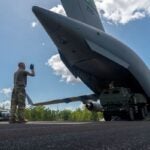Raytheon [RTN] yesterday said it received an $81 million Army contract to develop and produce a new version of the Advanced Field Artillery Tactical Data System (AFATDS). The contract extends over a 24-month period, with an $18 million, 12-month option. The new AFATDS version is to provide general and fires command and control capabilities to ground forces, from mission planning to execution. AFATDS is designed to integrate and use information from a variety of sources to create a common operational…
Contract Updates
ICF Mercantile LLC (Warren, New Jersey) – $150,000,000
ICF Mercantile LLC,* Warren, New Jersey, has been awarded a maximum $150,000,000 firm-fixed-price delivery order (SP8000-26-F-0008) issued against an indefinite-delivery/indefinite-quantity contract (SP8000-26-D-0005) for aerospace grade rayon fiber. This was a sole-source acquisition using justification 10 U.S. Code 3204 (a)(3)(A), as…
Lockheed Martin Corp. (Orlando, Florida) – $328,500,000
Lockheed Martin Corp., Orlando, Florida, was awarded a ceiling of $328,500,000 undefinitized contract action issued as a letter contract for Department of Defense and Foreign Military Sales (FMS) Sniper, Infrared Search and Track, and Low Altitude Navigation and Targeting Infrared…
Zapata Black & Veatch JV LLC (Charlotte, North Carolina) – $29,000,000
Zapata Black & Veatch JV LLC, Charlotte, North Carolina, was awarded a $29,000,000 firm-fixed-price contract for planning, design, construction, and operation services. Bids were solicited via the internet with six received. Work locations and funding will be determined with each…
Burns & McDonnell Engineering Co. Inc. (Kansas City, Missouri) – $49,000,000
Burns & McDonnell Engineering Co. Inc., Kansas City, Missouri, was awarded a $49,000,000 firm-fixed-price contract for planning, design, construction, and operation services. Bids were solicited via the internet with four received. Work locations and funding will be determined with each…

 By
By 











